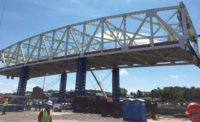
From a joint project risk-management program to extremely large drilled shafts using an oscillator, the $134-million replacement of the Henry G. Gilmerton Bridge in Chesapeake, Va., features many innovations, including erecting components of a new 1,908-ft-long vertical-lift bridge beneath and above a 75-year-old twin bascule bridge.
The Gilmerton Bridge carries an average of 35,000 vehicles daily and lifts its bascule 7,500 times a year. Now in phase three, the project to replace the old bridge over the Elizabeth River began in 2009 and is scheduled for completion in 2014. The new design increases vertical clearance by 24 ft to allow ships to pass with fewer bridge openings. The new bridge's 85-ft width will carry four lanes with room for two more when needed.
During foundation work, completed during phase one in summer 2011, crews built eight 12-ft-dia, 124-ft-deep drilled shafts—among the largest ever constructed in the U.S. using the oscillator method—with temporary casings. This method minimizes vibrations to near-zero levels, says Marc Papini, project manager with Parsons Brinckerhoff, prime consultant for the Virginia Dept. of Transportation. The oscillators, custom-designed by Saarland, Germany's Leffer GmbH, can exert five million foot-pounds of torque. A load cell attached to one drilled shaft verifies the shaft's design capacity, Papini says.
The contractor tested shaft integrity with cross-hole sonic logging. "In [our] risk-management planning, we had a procedure for core-drilling the shaft, then looking at the data in anticipation of anomalies in the testing of the shaft," Papini says. The early-detection method saved as much as a month of delay off the critical path, the manager says.
The procedures are part of a joint project risk-management program developed at VDOT and being tested on this job. "When everybody knows what to expect, we are actually proactively managing disputes by [anticipating] problems ahead of time," says Mark Cacamis, VDOT state construction engineer, who compares the program to integrated project delivery in a public setting. "We moved from partnering into full stakeholder risk management. We sit down and talk about the risks together." For instance, the owner, engineer, contractor and construction manager "decided on the means and methods of how to install the drilled shafts, including potential cost to the contractor," Cacamis notes.
After the drilled shafts were installed, crews erected the 220-ft towers and eight 15-ft-dia, 120,000-lb sheaves, while another team built the new bridge off-site. "By building the new foundations under the existing bridge, then [the superstructure] on top after the steel was in place, we basically had to swallow the existing structure," says Jim Holtje, project manager for PCL Civil Constructors Inc., Chesapeake, Va.
Early on Jan. 7 at the assembly yard in Norfolk, the new lift span was loaded onto a barge and floated seven miles down the Elizabeth River, arriving at the site just before noon. At 5:30 a.m. the following morning, Papini recalls standing out on the old Gilmerton Bridge as the sun was rising. "I was looking north into the river, and suddenly the new 5.2-million-lb lift span floating on a barge came into view," he says. "It was an amazing sight."
Everybody stayed in constant communication, Papini says. "The tug operators were discussing the maneuver, while people at bearing locations were monitoring tolerances and the speed at which the barge was floating," he says. "Once the barge arrived at the site, the operator let in water to lower it into position for unloading the span." It was placed on the bearings between the two 220-ft towers, with 1.5 in. of clearance on either side.
In the final phase, crews will demolish the old bascule bridge's piers, install new fenders and a dolphin protection system, and build northern approach bridges before opening up all four travel lanes to the public.
This article was updated on March 1, 2013, for accuracy. The contractor used a single oscillator; the bascule bridge is raised 7,500 times a year; and a single load cell verifies shaft-design capacity.



Post a comment to this article
Report Abusive Comment